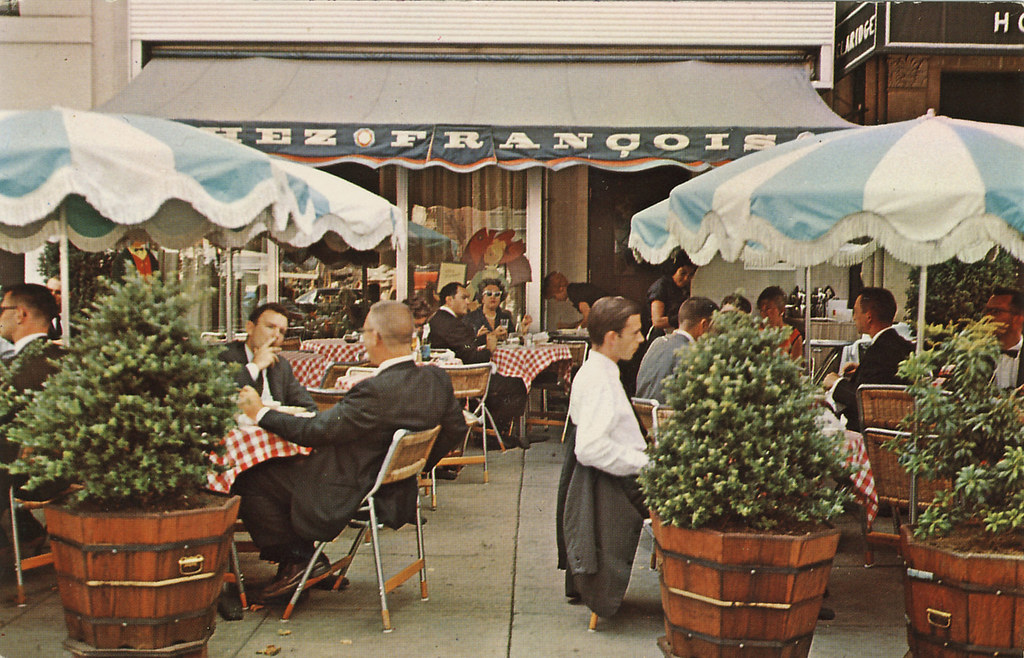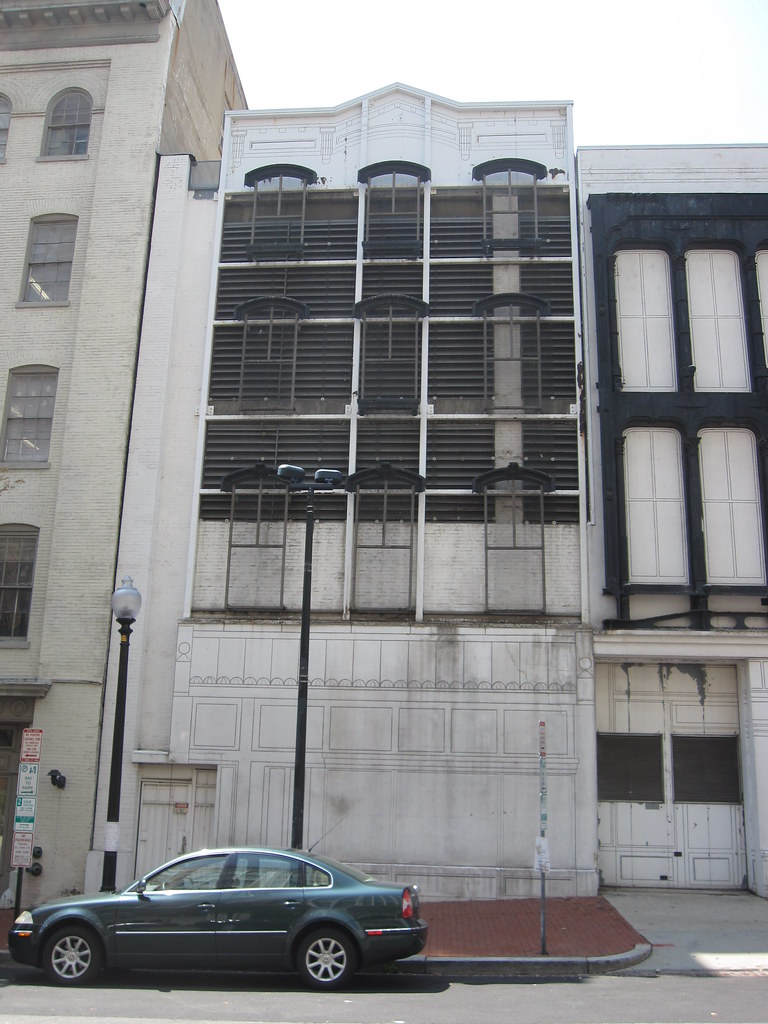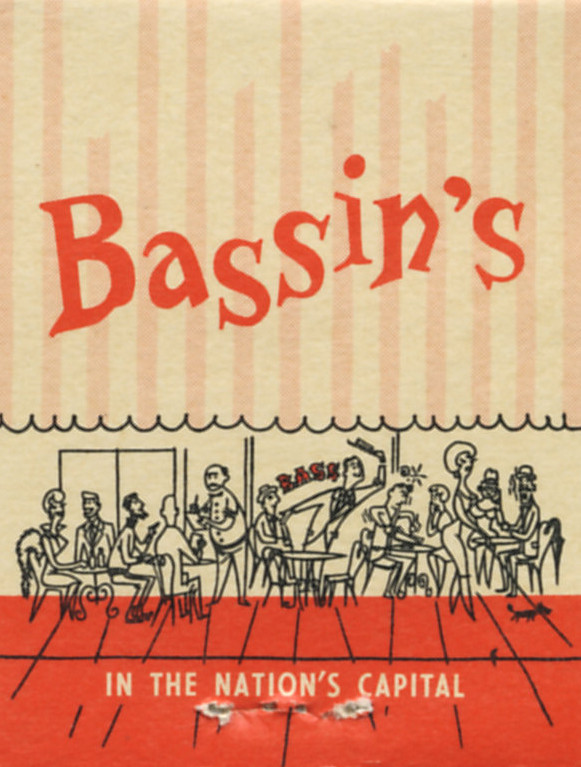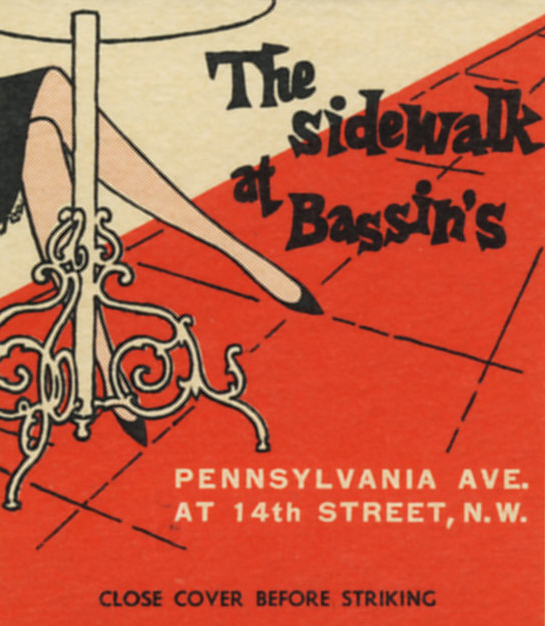Bassin's Restaurant, Washington's First Sidewalk Café
A modest, four-story storefront once stood near the corner of 14th Street and Pennsylvania Avenue NW overlooking Washington's first sidewalk café. From an illegal gambling parlor to a trendy 1960s discotheque, the building saw much in the way of what Washington had to offer for nighttime entertainment. It began its colorful career in about 1872, although according to an assessment prepared by the Historic American Buildings Survey, its architect and exact date of construction are unknown. Its classic Italianate facade was of pressed brick with ornamental cast-iron window hoods and sills.
The building was on a stretch of E Street (between 13th and 14th Streets NW) that was once considered to be part of Pennsylvania Avenue and that was known since the mid-19th century as "Rum Row" for its drinking and gambling dens. According to journalist George Rothwell Brown, the bottom floor was occupied by John Lawrence Kidwell's drugstore, and it had marble floors and interior woodwork of beautiful carved mahogany. Kidwell was known as the "Quinine King" for having supplied various pharmaceuticals to the Union Army during the Civil War. Upstairs was the celebrated gambling house of George Parker, where the "best known faro bank in town" operated. "A Chinese restaurant now serves chop suey in the rooms which in the hectic past were dedicated to the Goddess of Fortune and which echoed to the whir of the roulette wheel and the click of dice," wrote Brown in The Washington Post in 1923. By 1887, a tobacconist by the name of Daniel Loughran had moved into the ground floor. He and his sons ran their business there until 1929.
Over the next ten years, an assortment of other commercial enterprises came and went, including offices of The New York World and the National Press Club and what Brown called "various drinking clubs." Then in 1939 Max Bassin opened his restaurant there. Born in New York, Bassin had moved to D.C. as a child and attended Cardozo (Business) High School. He worked at the Treasury Department from 1933 until he decided to quit and start Bassin's Restaurant. He went in on it with his wife, Sarah, and her brother, Harry Zitelman. Bassin's was a rather ordinary lunchroom-style restaurant for many years, concentrating on selling corned-beef sandwiches for 25 cents and hot dogs for a dime. Then in 1949, Bassin decided to quit the business and devote his attention to real estate. He left the restaurant in the hands of his sister and Harry Zitelman.
 |
D. Loughran & Co. occupies the ground floor of 1347 Pennsylvania Avenue NW (the white building) in this circa 1920 view (Source: Library of Congress).
The building was on a stretch of E Street (between 13th and 14th Streets NW) that was once considered to be part of Pennsylvania Avenue and that was known since the mid-19th century as "Rum Row" for its drinking and gambling dens. According to journalist George Rothwell Brown, the bottom floor was occupied by John Lawrence Kidwell's drugstore, and it had marble floors and interior woodwork of beautiful carved mahogany. Kidwell was known as the "Quinine King" for having supplied various pharmaceuticals to the Union Army during the Civil War. Upstairs was the celebrated gambling house of George Parker, where the "best known faro bank in town" operated. "A Chinese restaurant now serves chop suey in the rooms which in the hectic past were dedicated to the Goddess of Fortune and which echoed to the whir of the roulette wheel and the click of dice," wrote Brown in The Washington Post in 1923. By 1887, a tobacconist by the name of Daniel Loughran had moved into the ground floor. He and his sons ran their business there until 1929.
Over the next ten years, an assortment of other commercial enterprises came and went, including offices of The New York World and the National Press Club and what Brown called "various drinking clubs." Then in 1939 Max Bassin opened his restaurant there. Born in New York, Bassin had moved to D.C. as a child and attended Cardozo (Business) High School. He worked at the Treasury Department from 1933 until he decided to quit and start Bassin's Restaurant. He went in on it with his wife, Sarah, and her brother, Harry Zitelman. Bassin's was a rather ordinary lunchroom-style restaurant for many years, concentrating on selling corned-beef sandwiches for 25 cents and hot dogs for a dime. Then in 1949, Bassin decided to quit the business and devote his attention to real estate. He left the restaurant in the hands of his sister and Harry Zitelman.
Zitelman, who was the son of Russian immigrants and had grown up in Baltimore, capitalized on Bassin's prime location near the National and Warner theaters, various newspaper offices, the Willard Hotel, and the District Building. As time went on, Zitelman built Bassin's up until it was a well-known Washington institution. He expanded into the building on the corner, making Bassin's a sprawling complex that was frequented by both tourists and natives alike. And like all top-drawer restaurateurs, Harry Zitelman was a consummate showman. He didn't just work hard to promote Bassin's; he made sure everybody knew he was doing it.
As reported in The Washington Post, Harry Zitelman and Jean Moran of L'Espionage at 2900 M Street NW sought permission in early 1959 from the District's Board of Commissioners to set up sidewalk cafés. The request was not well-received. One concern was a 1934 law that banned consumption of alcoholic beverages on District sidewalks—although it was not clear that serving any kind of food or beverages would be legal. Opinions about the proposal touched on many other issues as well. The Post talked to Leonard Carmichael, secretary of the Smithsonian, who said he had "enjoyed looking at sidewalk cafes in Spain and Rome, but I'm not sure I would enjoy them in Washington." Why not? He apparently didn't say. Prominent socialite Gwendolyn Cafritz held that "Washington is just perfect the way it is. I don't think the tempo of Washington is suited to sidewalk cafes. Nobody would have time to sit in them."
These were just the opening salvos in the two-year struggle to bring sidewalk dining to Washington. While Moran seems to have dropped out of the fight, Zitelman kept pushing. In late 1960, a ruling came down denying Zitelman's request on the grounds that alcoholic beverages couldn't be served on the sidewalk. Zitelman responded by asking for a permit to open his sidewalk eatery without the alcohol. At a March 1961 hearing before the Board of Commissioners, Zitelman presented a stylish, Parisian-looking sketch of how his proposed sidewalk café might look. But not all hearts and minds were won.
As reported in the Post on March 17, 1961, an assortment of D.C. government witnesses outlined a litany of perils that would befall the hapless citizenry if sidewalk cafés were allowed in the District. These hazards included the following:
Indeed, it became clear that city officials had overstepped in their opposition to the idea. The Post ran an editorial favoring it; Art Buchwald wrote a column making fun of the city's objections. By the time a public hearing was held in June, most everybody was behind the idea, with rare exceptions, such as H.B. Niece, executive vice president of the Organized Bible Class Association. As the Post reported, Niece thought the cafés would encourage public drunkenness and panhandling and amounted to "a Castro grab of public property." His objections were overruled, as it were.
The Sidewalk At Bassin's opened with much fanfare in August 1961 and was an instant success. Zitelman found his overall business up 15 percent. Still, there were complaints that the café should serve "something beside malts," so Zitelman worked to get the alcoholic beverage ban lifted, which he achieved the following year. In 1962, Washington's second sidewalk café opened at Chez Francois on Connecticut Avenue NW. By 1963, some 20 different restaurants had joined in, and the sidewalk café had become an established part of D.C.culture.
The sidewalk café wasn't Zitelman's only innovation at the Bassin's complex. He also opened one of the city's first discotheques, called the Top O' the Walk Twist Room, in the former Atlas Club upstairs from the dining room in 1962. According to the Post, Zitelman got the idea after seeing Chubby Checker dancing the twist in New York. The Post's arts commentator, John Pagones, visited in April 1962 and was very enthusiastic. "The Fred Astaire dancers give twist lessons every night but it seems like bringing politics into Washington. Those people can really twist. The supply seems bottomless." Ranging about Bassin's, Pagones noted that in addition to the dining room and cafeteria, there was also a lounge where "Jerry White knocks the daylight out of a piano with his honky-tonk songs," as well as a "noisy, chummy rathskellar" in the basement called L'Escapade Room. These were Bassin's salad days, so to speak, and unfortunately there would not be many more of them.
Bassin's was picketed in the mid-1960s for its hiring practices. It was accused of keeping most African-American employees in the kitchen and using mostly whites for the "out front" positions, such as waiters and waitresses. Bassin's agreed to hire more equitably, but business began to decline anyway after the April 1968 riots. In 1976, the restaurant was sold to a wealthy South Vietnamese family that had decided to move to Washington and get into an American type of business. Then, after only two years, the restaurant was gutted in a suspicious pre-dawn fire in October 1978. The police arson squad told the Post that they were 75 percent sure that the fire was started by igniting a flammable fluid. However, by that time the building was already slated to be torn down to make way for a massive new hotel/office complex. Within a year, with the blessing of the Pennsylvania Avenue Development Corporation, the burned-out structure was razed. The J.W. Marriott Hotel now stands on the site.
Still, a few shards have survived of this venerable little building that witnessed so much of everyday Washington life. On 8th Street NW, just down from the other little commercial building we recently profiled, a few of the metal window hoods and sills from Bassin's are hung ghost-like over large vents at a Pepco substation. If they look a bit pathetic hung up that way, what's worse is that there's no sign telling where they came from.
These were just the opening salvos in the two-year struggle to bring sidewalk dining to Washington. While Moran seems to have dropped out of the fight, Zitelman kept pushing. In late 1960, a ruling came down denying Zitelman's request on the grounds that alcoholic beverages couldn't be served on the sidewalk. Zitelman responded by asking for a permit to open his sidewalk eatery without the alcohol. At a March 1961 hearing before the Board of Commissioners, Zitelman presented a stylish, Parisian-looking sketch of how his proposed sidewalk café might look. But not all hearts and minds were won.
 |
| Bassin's in 1967 (Source: Historic American Buildings Survey) |
As reported in the Post on March 17, 1961, an assortment of D.C. government witnesses outlined a litany of perils that would befall the hapless citizenry if sidewalk cafés were allowed in the District. These hazards included the following:
- Pedestrian traffic would be disrupted. People would be forced to walk in the streets and probably get run over.
- Food would be exposed to dust, dirt, and "windblown foreign matter," creating a health hazard.
- Hungry birds, insects, and rodents—especially squirrels—would discomfit patrons, and the city's rodent control problem would be "multiplied many times."
- Chairs and tables would interfere with the laying of hoses during a fire.
- Street litter would be exacerbated.
- Street-spraying trucks might splash water over the curbs and on to customers.
- It would be harder to do utility work, which might require tearing up the sidewalks.
- The cafes would be a "potential source of disorder" because café patrons might brush against sidewalk pedestrians, possibly leading to fisticuffs, etc.
- Passersby might steal pocketbooks or other valuables from café patrons.
- And finally, according to Deputy Police Chief Howard V. Covell, "this type of operation would provide a favorable setting for ladies of easy virtue as they ply their trade up and down the street."
Indeed, it became clear that city officials had overstepped in their opposition to the idea. The Post ran an editorial favoring it; Art Buchwald wrote a column making fun of the city's objections. By the time a public hearing was held in June, most everybody was behind the idea, with rare exceptions, such as H.B. Niece, executive vice president of the Organized Bible Class Association. As the Post reported, Niece thought the cafés would encourage public drunkenness and panhandling and amounted to "a Castro grab of public property." His objections were overruled, as it were.
The Sidewalk At Bassin's opened with much fanfare in August 1961 and was an instant success. Zitelman found his overall business up 15 percent. Still, there were complaints that the café should serve "something beside malts," so Zitelman worked to get the alcoholic beverage ban lifted, which he achieved the following year. In 1962, Washington's second sidewalk café opened at Chez Francois on Connecticut Avenue NW. By 1963, some 20 different restaurants had joined in, and the sidewalk café had become an established part of D.C.culture.
 |
| Chez Francois was the second restaurant to open a sidewalk cafe, seen in this circa 1963 postcard. |
The sidewalk café wasn't Zitelman's only innovation at the Bassin's complex. He also opened one of the city's first discotheques, called the Top O' the Walk Twist Room, in the former Atlas Club upstairs from the dining room in 1962. According to the Post, Zitelman got the idea after seeing Chubby Checker dancing the twist in New York. The Post's arts commentator, John Pagones, visited in April 1962 and was very enthusiastic. "The Fred Astaire dancers give twist lessons every night but it seems like bringing politics into Washington. Those people can really twist. The supply seems bottomless." Ranging about Bassin's, Pagones noted that in addition to the dining room and cafeteria, there was also a lounge where "Jerry White knocks the daylight out of a piano with his honky-tonk songs," as well as a "noisy, chummy rathskellar" in the basement called L'Escapade Room. These were Bassin's salad days, so to speak, and unfortunately there would not be many more of them.
 |
| Bassin's is seen here in 1979, after it had been gutted by fire. The large building to the right is the Munsey Building. All these buildings (except for the National Theater, just visible on the far right) were torn down to make way for the J.W. Marriott hotel. (Source: Historic American Buildings Survey). |
Bassin's was picketed in the mid-1960s for its hiring practices. It was accused of keeping most African-American employees in the kitchen and using mostly whites for the "out front" positions, such as waiters and waitresses. Bassin's agreed to hire more equitably, but business began to decline anyway after the April 1968 riots. In 1976, the restaurant was sold to a wealthy South Vietnamese family that had decided to move to Washington and get into an American type of business. Then, after only two years, the restaurant was gutted in a suspicious pre-dawn fire in October 1978. The police arson squad told the Post that they were 75 percent sure that the fire was started by igniting a flammable fluid. However, by that time the building was already slated to be torn down to make way for a massive new hotel/office complex. Within a year, with the blessing of the Pennsylvania Avenue Development Corporation, the burned-out structure was razed. The J.W. Marriott Hotel now stands on the site.
Still, a few shards have survived of this venerable little building that witnessed so much of everyday Washington life. On 8th Street NW, just down from the other little commercial building we recently profiled, a few of the metal window hoods and sills from Bassin's are hung ghost-like over large vents at a Pepco substation. If they look a bit pathetic hung up that way, what's worse is that there's no sign telling where they came from.
 |
| Elements of the Bassin's building now on 8th Street NW. |







John,
ReplyDeleteAnother astounding blog entry!
Terrific! The picture of changing Washington life and attitudes is a delight! More, please!
ReplyDeleteBeing able to people-watch along the sidewalk while enjoying a good meal is part of the joy of living in Washington. I bet those people who were objecting to it were the same folks who claimed that rock 'n roll was the devil's music and would turn American teens into a bunch of satan worshippers. Oh, wait....
ReplyDeleteTrio at 17th and Q was the second and, of course, it's still open for business.
ReplyDelete-downtown rez
How interesting! I never would have known! I immediately started to follow this blog. Thank you!
ReplyDeleteWonderful. as usual.
ReplyDeleteKeep it up.
Next should come a book.
I love how you can see the old architectural shadow or the original Richardsonian Romanesque Washington Post building on the larger building to the right. What a loss.
ReplyDeleteLovely post as usual.
The Pennsylvania Avenue Development Corporation (PADC) purchased Bassin's and the remainder of the block save for the National Press Building and 1301 Pa. Ave. It issued a development Prospectus for the site (Parcel 254-A), which also included the National Theatre building, seeking proposals from developers. It received three proposals and selected Quadrangle Development Corp. to execute the proposal it submitted, which retaind and proposed to renovate the National Theatre (which it did), develop a Marriott Hotel, offices, and a retail component that the Rouse Company, then of Fanueil Hall and HarborPlace fame, would lease and manage.
ReplyDeleteI can't recall if PADC contracted for the demolition and delivered a cleared site or if Quadrangle undertook the demoltion, but I will ask one of my former PADC colleagues if they remember.
Thank you for the details about PADC's actions on this block! It was not readily apparent to me where the PADC's records have been archived and whether they are accessible. I presume NARA should have them somewhere. Any insights on that issue?
ReplyDeleteAs young marines stationed at Marine Headquarters, Bassin's was well known to us as a place to meet young secretaries and interns and to watch pretty girls walk by in their summer dresses. Following Kennedy's inaugural parade, it was a place for those of us assigned to parade control to unwind. It regrettable that that place with it's Parisian ambiance no longer exists.
ReplyDeleteMy late Uncle is Jerry White, who performed there in the 60s. If anybody saw him perform I would love to hear about him. Thank you.
ReplyDeleteI saw your uncle perform several times while I was in the Navy and stationed for two years (1969-1971) in the DC area. A Navy buddy told me and my friends that we should go and hear the fantastic ragtime piano player at Bassin’s in downtown DC, and so we did. I recall that your uncle was quite a showman. One thing in particular I remember him doing was placing a tablecloth over the keys and playing! And he was lightning fast—really talented! The first time I saw him was in 1970. I left DC in July,1971.
DeleteMy grandfather is Harry Zitelman - I'd love to connect with you about your Uncle playing at Bassin's.
DeleteI am Harry's son (and Amy's Uncle) and heard Jerry many times. I have several records and am looking to complete the collection.
DeleteHere is a short Bio on Jerry and a link to a YouTube presentation:
Jerry White was born in Neptune, N.J. August 15, 1935 and died in Washington D.C. February 6, 1971. He was a popular self-taught Ragtime Stride piano player in Washington, entertaining patrons with their favorite sing-along music and with his 'blazing piano solos.' On occasions, he performed while wearing gloves, at times blindfolded, and regularly made a feature of playing presto arrangements with the keyboard covered with a red-checked tablecloth. His unbelievable keyboard dexterity and rhythmic style kept Jerry White employed at Bassin's L'Escapade Room, Pennsylvania Ave. and 14th St. for twelve years. He recorded two albums, Honky Tonkin' (1959) and White Lightning (1964) for Monument Records, Nashville, Tenn. A third album of twelve solos, Downtown with Jerry White was recorded in 1969. His sustained tickling of keys, creative left and right hands rhythmic syncopations, and blazing Stride improvisations provide for an exceptional listening experience of brilliant Piano Jazz.
Here is a YouTube of him in 1968. This is the only live recording or video I can find:
https://www.youtube.com/watch?v=e1a8QI-jz6c
In 1966 my friend Jack and I used to eat at Bassins quite often. I especially remember the pickled herring in sour cream. Delicious. We were studying Laotian language in preparation for our overseas assignment as IVS volunteers in Laos. A great place that I have never forgotten.
ReplyDeleteI saw your uncle perform several times while I was in the Navy and stationed for two years (1969-1971) in the DC area. A Navy buddy told me and my friends that we should go and hear the fantastic ragtime piano player at Bassin’s in downtown DC, and so we did. I recall that your uncle was quite a showman. One thing in particular I remember him doing was placing a tablecloth over the keys and playing! And he was lightning fast—really talented! The first time I saw him was in 1970. I left DC in July,1971.
ReplyDeleteI went to Bassin's several times in late 1968 and early 1969 with my boyfriend. Reading this article makes me think we went to the L'Escapade Room, because I remember it being very crowded and noisy. However, I also recall the piano player suddenly breaking into "Dixie", whereupon much of the audience would stand and raucously sing. That included my Florida native boyfriend, although not me, since I was from Michigan. So, I'm wondering if we in fact were in the lounge, where the article says Jerry White played, or if he wandered down into the basement to share his talents with the partiers in the dark. Whatever the Bassin's room we went to, I remember always dressing in my fancy duds. Thanks for the memories, bittersweet as they are.
Delete